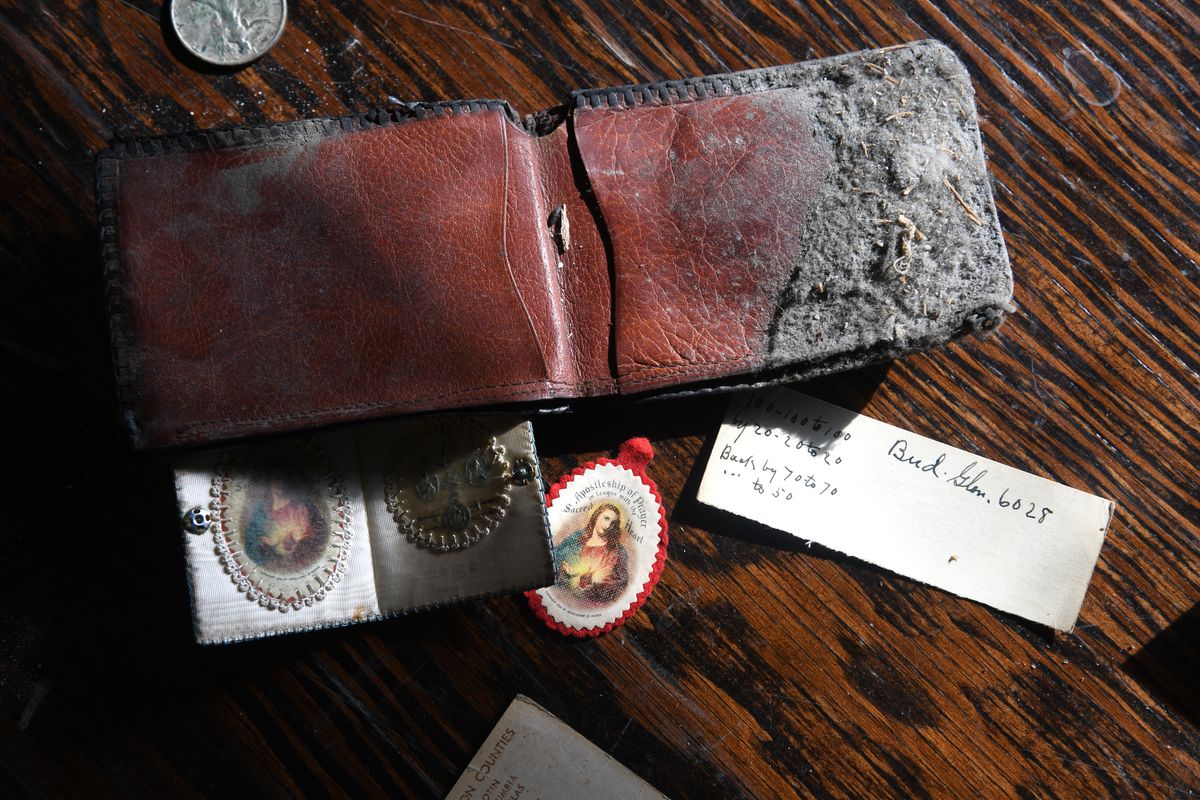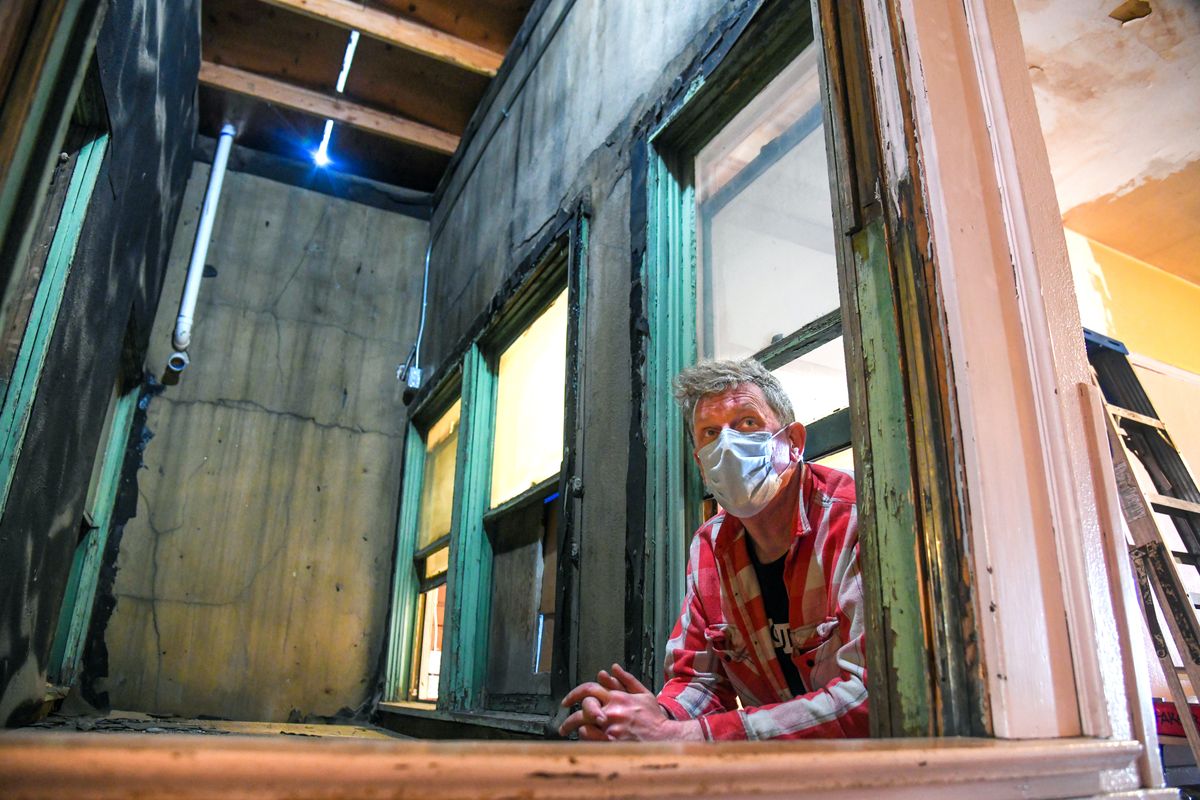A new owner, an old feel: Inside Hillyard’s historic Kehoe block as an iconic building changes hands again

In a two-story brick storefront off Market Street, Bob Whittaker found himself a time capsule.
“Basically, we’re just huge historic preservation fans,” Whittaker said, referring to himself and girlfriend, Sandra Bilbrey, who bought the historic Kehoe block at the end of August. “That’s why (in) some of these rooms, we’ve just washed the walls.”
The 1907 brick structure bearing the name of two giants in the early days of Hillyard has been home to a bar, a hardware store and more on the street level at Olympic Avenue and Market Street. But enter the building at the rear, and climb the old wooden steps where Agnes Kehoe could once spy boarders trying to sneak in dates afterhours, and you emerge into an old railroad single room occupancy lodging house largely untouched by the hands of time.
“Not that I wasn’t up and down fairly often,” said Sue Bergman, owner of The B&B Junk Company antique mall that has operated in the downstairs space since the early 1990s. “A lot of my customers were really curious about what the upstairs was. So if I knew them well enough, and was comfortable with them, I would just hand them the key.”

The Kehoe Hotel, as it was known, was built by Agnes and Thomas Kehoe in 1907, according to its application to be placed on the National Historic Register in 2002. Thomas Kehoe was a saloon owner who’d come to the area in the early 1900s, with Agnes following soon thereafter.
Both would make a mark in area politics. After being shot through the jaw in a robbery attempt gone awry in November 1905, Thomas Kehoe ran for the Hillyard City Council and was later elected the town’s mayor prior to its annexation into Spokane in 1924.
Agnes Kehoe was elected to the state Legislature in 1938 and served four terms as one of the first women lawmakers in the state’s history.
“I am making but two campaign promises,” Agnes Kehoe would tell voters, according to a newspaper columnist’s account in January 1939. “Not to get drunk and not to sell my vote.”
A painting of Thomas Kehoe, kept by Bergman, hung earlier this month in the makeshift office Whittaker is using while sprucing up the property. Whittaker’s given his tenant a two-year commercial lease to continue selling antiques following what he described as an unlikely purchase earlier this year.
“I walked up to her and I said, ‘Hey, I know your building’s not for sale,’” Whittaker recalled. “And she’s like, ‘Everything’s for sale, honey.’”
With that, Whittaker was handed the keys to the upstairs rooms, 18 of them in total. It was in the bathroom that he discovered one of the most personal relics of the time capsule.
Home for railroad men
The wallet had to have fallen when retired railroad engineer Joseph McDougall was shaving or taking a shower, as Whittaker figures it.
“The wallet, and some underwear and socks were back there,” Whittaker said, pointing to an area of the shared bathroom where he’d recently removed a water heater to fix the plumbing. “So, either someone ripped off the guy’s wallet and threw it back here, or he put his pants up there and it dropped out.”
If someone stole the wallet, it had to have been one of McDougall’s neighbors. The former Great Northern Railroad engineer, who died in March 1966 at 90, lived in the Kehoe’s rooms for some time around the middle of the 20th century.
That’s according to his grandchildren, Barbara Cossette and James Hutton, who still live in the area. Cossette and Hutton were identified with help from members of the Eastern Washington Genealogical Society.
“He ended up living by himself, that’s how he ended up in the Kehoe apartments,” Hutton said.
The wallet appears to have been discarded some time in the 1940s, based on its contents. They included a Social Security card dated Aug. 2, 1937, two years after the social welfare program lauded by President Franklin Delano Roosevelt was passed. Also within were an individual permit to buy liquor that expired Sept. 30, 1949, and a campaign card for Sheriff James Cannon, who died in office in June 1944.
Both grandchildren remembered picking McDougall up and taking him to Sunday dinner. He was a parishioner at St. Patrick’s in Hillyard, where his funeral eventually was held.
Hutton suspects McDougall must have known Thomas Kehoe, who died in June 1946. Both were Midwestern men, Kehoe from Green Bay, Wisconsin, and McDougall from Glencoe, Minnesota.
Agnes Kehoe was known for her hospitality to the railway men, according to a remembrance published in a 2002 edition of The Spokesman-Review. The city’s Parks Department was in the midst of considering a new park at Nelson Street and Wabash Avenue for the Kehoes when Don Shane wrote that Mrs. Kehoe was a thoughtful caregiver.
“I contracted a terrible cold and was laid up in my room for three days,” Shane wrote of living in the Kehoe block rooms in 1947, when he worked for Great Northern. “One day Mrs. Kehoe knocked on my door and served me a hot toddy she said could cure anything. And she was right.”

The Parks Department named the park for the Kehoes later that year. A Spokane Housing Authority low-income apartment building in Hillyard also bears Agnes Kehoe’s name.
McDougall was an engineer on what was then known as the Marcus Division, rail service that ran from Spokane up through Colville and Kettle Falls on into British Columbia. That’s where Hutton’s mother, Mary Grace McDougall, was born.
A good steward
The rough and tumble days of Hillyard that led to Thomas Kehoe’s gunshot wound are gone, Whittaker said, and it’s likely headed for a new era as completion of the North Spokane Corridor will continue over the next decade.
Under Thomas Kehoe’s gaze from the portrait, Whittaker cast his eyes out the back window, to an area being graded for the new highway.
“That’s the old post office,” Whittaker said, pointing to the squat building built for sorting mail by Thomas Kehoe right before his death in 1946. “Just on the other side of that is going to be the Children of the Sun bike trail, which I’m really excited about.”
“That’s going to be so good for the neighborhood,” said Whittaker, who is also an advocate for cycling and pedestrian trails in rural parts of Washington.
He’s just the fourth owner of the building, after the Kehoes, Lloyd Stussi and then Bergman, who describes Hillyard as a blue-collar, welcoming neighborhood that defies the “Dogtown” stigma that has plagued it for decades.
Bergman told the story of two female customers looking for a place to go to lunch. The shop owner suggested a tavern down the street that made some good sandwiches, but the women expressed uncertainty before walking out the door.
Bergman later found them at the tavern tossing darts with the locals.
“I said, well, I guess you’re not afraid to have lunch in Hillyard,” Bergman remembered telling the ladies.
Stussi, who kept the hardware store, made an attempt to fix up the boarding rooms, but promptly abandoned it when he found out the code issues that would have to be addressed, Bergman said.
Whittaker plans to live upstairs, while maintaining the neighborhood’s charm. A charm that in many ways was built by Agnes Kehoe, her husband and their commercial and philanthropic efforts headquartered in the old building off Olympic.
“They’ve been stewards of this place, and all the cool history,” Whittaker said of Bergman and the other previous owners. “And it’s sort of been preserved by her. And we’re just an extension of that.”